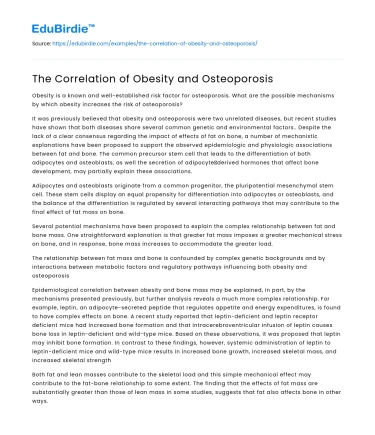Obesity is a known and well-established risk factor for osteoporosis. What are the possible mechanisms by which obesity increases the risk of osteoporosis?
It was previously believed that obesity and osteoporosis were two unrelated diseases, but recent studies have shown that both diseases share several common genetic and environmental factors.. Despite the lack of a clear consensus regarding the impact of effects of fat on bone, a number of mechanistic explanations have been proposed to support the observed epidemiologic and physiologic associations between fat and bone. The common precursor stem cell that leads to the differentiation of both adipocytes and osteoblasts, as well the secretion of adipocyte‐derived hormones that affect bone development, may partially explain these associations.
Save your time!
We can take care of your essay
- Proper editing and formatting
- Free revision, title page, and bibliography
- Flexible prices and money-back guarantee
Adipocytes and osteoblasts originate from a common progenitor, the pluripotential mesenchymal stem cell. These stem cells display an equal propensity for differentiation into adipocytes or osteoblasts, and the balance of the differentiation is regulated by several interacting pathways that may contribute to the final effect of fat mass on bone.
Several potential mechanisms have been proposed to explain the complex relationship between fat and bone mass. One straightforward explanation is that greater fat mass imposes a greater mechanical stress on bone, and in response, bone mass increases to accommodate the greater load.
The relationship between fat mass and bone is confounded by complex genetic backgrounds and by interactions between metabolic factors and regulatory pathways influencing both obesity and osteoporosis
Epidemiological correlation between obesity and bone mass may be explained, in part, by the mechanisms presented previously, but further analysis reveals a much more complex relationship. For example, leptin, an adipocyte-secreted peptide that regulates appetite and energy expenditures, is found to have complex effects on bone. A recent study reported that leptin-deficient and leptin receptor deficient mice had increased bone formation and that intracerebroventricular infusion of leptin causes bone loss in leptin-deficient and wild-type mice. Based on these observations, it was proposed that leptin may inhibit bone formation. In contrast to these findings, however, systemic administration of leptin to leptin-deficient mice and wild-type mice results in increased bone growth, increased skeletal mass, and increased skeletal strength
Both fat and lean masses contribute to the skeletal load and this simple mechanical effect may contribute to the fat-bone relationship to some extent. The finding that the effects of fat mass are substantially greater than those of lean mass in some studies, suggests that fat also affects bone in other ways. A number of hormones may link the two tissues.






 Stuck on your essay?
Stuck on your essay?

